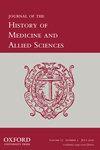哪种陌生人的疾病?大西洋革命时代的移民、免疫和古巴白化》。
IF 0.4
3区 哲学
Q4 HEALTH CARE SCIENCES & SERVICES
Journal of the History of Medicine and Allied Sciences
Pub Date : 2024-09-11
DOI:10.1093/jhmas/jrae022
引用次数: 0
摘要
1804 年,古巴医生托马斯-罗迈(Tomás Romay)试图制造出第一种黄热病疫苗,但最终以失败告终。这篇文章分析了他的实验努力,强调了处于这一早期疫苗试验中心的被奴役者和被征召者。尽管这是一次科学上的失败,但这一短暂的实验、其中蕴含的愿望和逻辑,以及实验后采取的措施--以欧洲增白运动的形式--让我们能够思考大西洋革命时代对免疫力的政治利用。文章将这些事件历史性地纳入加勒比地区更广泛的地缘政治中,阐述了黄热病免疫接种在古巴当局试图在反殖民和反奴隶制的反抗中巩固其政治和经济主权的过程中所发挥的核心作用。因此,文章展示了黄热病及其对社会和经济秩序的威胁如何与作为殖民治理机制的疫苗接种这一更广泛的历史相吻合。最后,通过将古巴预防黄热病的努力与被奴役者对健康的关注--可以说这些关注为他们反抗奴隶制提供了依据--结合起来,文章还展示了在古巴最初成为奴隶社会的时代,关于免疫和政治归属的想法是如何通过作为精英理想的白人而日益交织在一起的。本文章由计算机程序翻译,如有差异,请以英文原文为准。
Which Stranger's Disease? Immigration, Immunization, and the Whitening of Cuba in the Age of Atlantic Revolutions.
In 1804, Cuban physician Tomás Romay tried and failed to create the first yellow fever vaccine. The article analyzes his experimental efforts, foregrounding the enslaved and enlisted subjects at the center of this early vaccine trial. Though a scientific failure, this brief experiment, the desires and logics embedded within it, and the measures deployed in its wake - in the form of European whitening campaigns - allow us to consider the political uses of immunity during the Age of Atlantic Revolutions. Historicizing these events within the wider geopolitics of the Caribbean, the article explicates the central role that yellow fever immunization played in Cuban authorities' attempts to shore up their political and economic sovereignty in the midst of anti-colonial and anti-slavery resistance. As such, it shows how yellow fever and its threat to social and economic order fits within a broader history of vaccination as a mechanism of colonial governance. Finally, by situating Cuban efforts to prevent yellow fever alongside the health concerns of enslaved people - concerns that arguably informed their resistance to slavery - the article also demonstrates how ideas about immunity and political belonging increasingly intersected through whiteness as an elite ideal in the era that Cuba first became a slave society.
求助全文
通过发布文献求助,成功后即可免费获取论文全文。
去求助
来源期刊

Journal of the History of Medicine and Allied Sciences
管理科学-科学史与科学哲学
CiteScore
1.00
自引率
0.00%
发文量
40
审稿时长
>12 weeks
期刊介绍:
Started in 1946, the Journal of the History of Medicine and Allied Sciences is internationally recognized as one of the top publications in its field. The journal''s coverage is broad, publishing the latest original research on the written beginnings of medicine in all its aspects. When possible and appropriate, it focuses on what practitioners of the healing arts did or taught, and how their peers, as well as patients, received and interpreted their efforts.
Subscribers include clinicians and hospital libraries, as well as academic and public historians.
 求助内容:
求助内容: 应助结果提醒方式:
应助结果提醒方式:


